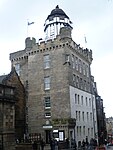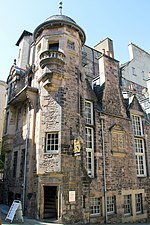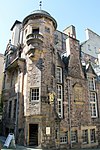The Hub, Edinburgh

The Hub is a public arts and events building in the centre of Edinburgh, Scotland. Located at the top of the Royal Mile, it is a prominent landmark as its tall gothic spire is the highest point in central Edinburgh, and towers over the surrounding buildings below Edinburgh Castle. The building is a notable example of Gothic Revival architecture and was designed by architects J Gillespie Graham and Augustus Pugin. Constructed between 1842 and 1845, it was originally designed as a meeting hall for the General Assembly of the Church of Scotland. From 1929 the building was used as a church until the mid-1980s. Today it is the home of the Edinburgh International Festival and is used as a ticket office, information centre and performance venue.
Excerpt from the Wikipedia article The Hub, Edinburgh (License: CC BY-SA 3.0, Authors, Images).The Hub, Edinburgh
Castlehill, City of Edinburgh Old Town
Geographical coordinates (GPS) Address External links Nearby Places Show on map
Geographical coordinates (GPS)
| Latitude | Longitude |
|---|---|
| N 55.948977777778 ° | E -3.1946472222222 ° |
Address
The Hub
Castlehill 348-350
EH1 2NE City of Edinburgh, Old Town
Scotland, United Kingdom
Open on Google Maps








